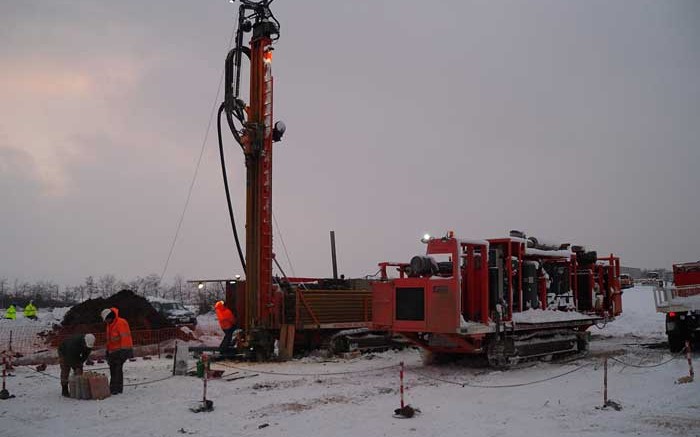VANCOUVER — When it comes to major discoveries over the past few years there are few that stand out in regards to grade and tonnage potential like Reservoir Minerals’ (TSXV: RMC; US-OTC: RVRLF) Timok copper porphyry in eastern Serbia, which is being developed under a joint venture with Freeport-McMoRan Copper & Gold (NYSE: FCX).
Reservoir chairman Miles Thompson took to the podium at the Association for Mineral Exploration British Columbia’s (AME BC) annual Roundup conference in Vancouver to talk about what it takes to launch an exploration company, as well as the state of financial markets for juniors.
One common theme of many talks at Roundup, which Thompson also touched on, is a disconnect that exists between the investment community and mineral explorers. Much discussion has been aimed at bridging the gap between financial firms — who measure a company’ success on a quarterly basis — and the longer time horizons needed by a mineral explorer to make economic discoveries.
“The reality is that we have to work through decades and decades to make discoveries and build mines. All this market stuff is just noise, and we have to find a way to run our business without getting caught up in it,” Thompson said during his presentation. “I’ve been in this industry for thirty years and this is my fourth bear market. We need to be counter-cyclical and have money to work through the good and bad markets. Our industry doesn’t seem to learn, with miners going out and buying expensive assets at the top of the market, and us explorers raising money when it’s easy and spending it all until we’re broke and have to go back, cap in hand.”
Thompson says that Reservoir has used the project-generator model to make sure its cash position remains strong regardless of market conditions. He describes his company as a “research and development team” that builds projects and defines targets for qualified mining companies.
Reservoir and Freeport have drilled 45,000 metres at Timok to date, which Thompson said is “totally unaffordable” for a junior outfit.
“We do not try to do the heavy lifting ourselves,” he continued. “To do that you need experienced teams, but you also need appropriately experienced teams. Since we fund our business through partnerships, it allows us to participate in a lot of opportunities, and fail often and quickly and, wherever possible, with other people’s money.”
Thompson said the roots of the Timok discovery extend more than a decade to his time with South Africa’s Gold Fields (NYSE: GFI). Reservoir opted to take new technologies and models to an old district, with the Carpathian region of Serbia having an industrial-scale copper–gold mining history dating back over a century.
Inspired by higher copper prices and advances in block-cave mining — which allows for bulk-mining underground deposits — Reservoir took modern geophysical techniques and started exploring for porphyry targets nearly 500 metres deeper than anyone had done before.
Reservoir announced an initial resource estimate on a high-sulphidation epithermal target at Timok called Cukaru Peki on Jan. 27. Timok’s inferred resource now stands at 65.3 million tonnes grading 2.6% copper and 1.5 grams gold per tonne for 1.7 million tonnes contained copper and 3.1 million contained oz. gold. The resource includes a higher-grade massive sulphide domain containing 6.8 million tonnes averaging 9.6% copper and 5.9 grams gold. All resource estimates use a 1% copper equivalent cut-off grade.
“What we’ve done in Serbia really touches on a lot of themes that are important for exploration companies in the world today, including focusing on deposit quality, where these kinds of assets make money regardless of market conditions,” Thompson said. “It’s also important to remain capitalized to sustain your exploration. These things aren’t found quickly, and that’s the main difference between quality exploration companies and the ‘paper hanging’ or ‘lottery ticket’-type of investing we see in the market.”
Reservoir’s model has allowed it to have US$15 million in its treasury in late January, and maintain a wider portfolio of wholly owned prospects in the Serbian mineral corridor. The company intends to continue its geophysical work in the district, which Thompson describes as a “camp-scale opportunity” that could yield even more targets similar to Timok.
The other criteria Reservoir always looks at are what Thompson calls the “soft issues.” He says geologists often get too hung up on finding a deposit, when socio-political concerns can often make building a mine impractical. In Serbia’s case, the mining history in the country has provided for strong infrastructure and a government supportive of foreign investment in the industry.
Reservoir shares have traded within a 52-week range of $2.14 and $6.30, and the company saw its shares jump 47¢ over the four trading days following Timok’s resource estimate en route to a $6.15 close at press time.
The company has 42 million shares outstanding for a $256-million market capitalization.
“A lot of people don’t like the joint-venture model because they say you’ve given away the majority of the project. But let’s get real here: you should never give big, yellow trucks to geologists, and this stuff is expensive. Be realistic if you’re going to explore for a large-scale deposit,” Thompson said.


Be the first to comment on "Reservoir Minerals chairman talks modern exploration, Timok"